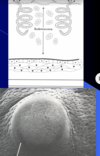Lecture 3 Flashcards
(26 cards)
Genital tract morphofisiology OVIDUCT (salpinx)

Histological structure

Oviductal mucosa
- Endosalpinx is made of primary secondary and tertiary folds.
- In the ampulla is thrown into high, branched fold that decreased in height toward the isthmus and become low ridges in the uterotubal junction. Almost completely fills the lumen

Oviductal mucosa (2)

Oviductal mucosa (3)
Secretory cells covered with microvilli and ciliated cells.
Some are completely ciliated others have cilia on the periphery
Fully ciliated cells in the fimbriae of the oviduct
Assist in the pick up of the ova after ovulation
Oviductal epithelium. Mucosal folds protrude in the oviductal lumen (ampulla)
Oviductal epithelium. Mucosal folds protrude in the lumen
of istmus)

Role of the oviduct
- Capturing oocyte (ovum pick-up)
- Oocyte passage in the oviduct afterovulation
- Oocyte maturation and nutrition
- Oocyte progresion tward thefecundation place
- Provide optimal environment for fertilization
- Sperm transport and capacitation
- Sperm nutrition
- Development of the early embryo

The uterus
Consists of two uterine horns, a body and a cervix (neck)
In cows is completely formed in IX/th month of embryonic live

Uterus: histology
- Mucosa (endometrium);
- Submucosa: compact; spongy;
- Muscularis (myometrium);
- Seroasa (perymetrium);
- Broad ligaments (parametrium).

Uterus: endometrium
Surface epithelium-s structure
includes -cylindrical-type of cells,
10% are ciliated
90% are non ciliated cells
10% of the latter have secreting
capacity
Due to the different nuclei placement of the
cells, endometrial epithelium looks pseudo
layered

Endometrial secretory cell

Uterus: histology
- By the plying of the mucosa in the depths of the endometrium, the uterine glands are formed
- Uterine glands are covered with a single layer of cuboid cells Secrete mucus;
- Secretory activity of glandular cells is subjected to hormonal control

Endometrium
In the estrogen phase of the sexual cycle
uterine glands proliferate, are thin, straight,
and tubular
accumulation of substances needed in the
synthesis process
they produce mucus, which is clear and
translucent
In the progesterone phase of the cycle, the
uterine glands become tortuous
Secretory cells produce a thicker fluid, more loaded
with nutrients, forming “uterine milk” or
“embryotrophe’.
Glandular epithelium is cylindrical; the cells have a
rich cariokinesis.
Interglandular stromal tissue has a dense
appearance, being composed of young connective
cells of small size, with numerous spiral shaped
arteries and veins
Uterus: myometrium

Endometrial cycle

Endometrial cycle (2)

Self defence
Cellular factors:
Circulatory system (granulocytes);
Loca l (macrophages, plasma cells, lymphocytes,
eosinophills hystiocites);
Under the estrogen influence phagocytosis increases.
Immunologic factors: antibodies, immunoglobulin G
and M flavoprotein, properdin;
Local specific antibodies.
Myometrial cycle

Myometrial cycle(2)

The role of the uterus
- The female uterus connects the cervix and oviduct
- Insures the male gamete migration,
- The migration of the zygote,
- Implantation and pregnancy development
Cervix Structure
- Sphicter-like structure that project s caudally into the vagina. It
- is a fibrous organ composed predominantly of connective tissue with only small amounts of smooth muscle tissue
- Similar structure of the uterus;
- Mucosa;
- Submucosa;
- Musculary;
- Serous;
- It have been localized, nerve ending corpuscles:
- Krause;
- Meissner;
- Ruffini.

Cervix(2)

Cervix mucosa
It is composed of:
- caliciform cell secretion;
- Blood transsudat;
- Uterine fluids;
- Oviductal follicular fluids
- Cellular debris, leukocytes from the uterine cavity.
Chemical:
- Polydispers system of glycoprotein molecules with a high
- degree of branching, forming a three-dimensional trickot like
- elastic network;

Cervical mucus functions?
Cervix = biological valve
Sperm migration depends on the following factors:
ability of sperm cells;
fibril structure, space, cavities;
biochemical composition of estrous mucus (mobility
increased by 200%);
proteolytic enzymes hydrolyze proteins of the micelium
core and increase access spaces;
The uneven distribution of sperm, more dense in
mucosal crypts.
Pathological processes and sperm-mucus
incompatibilities
cervical lethal factor, or “immobility” without apparent
specificity = anti-sperm antibodies;
Vagina
Vaginal mucosa presents numerous hormone
receptors;
Estrogens > congestion & swollen vulva
Attract the male, copulation ;
Promotes mitosis, proliferation of epithelium,
superficial cells cheratinisation;





